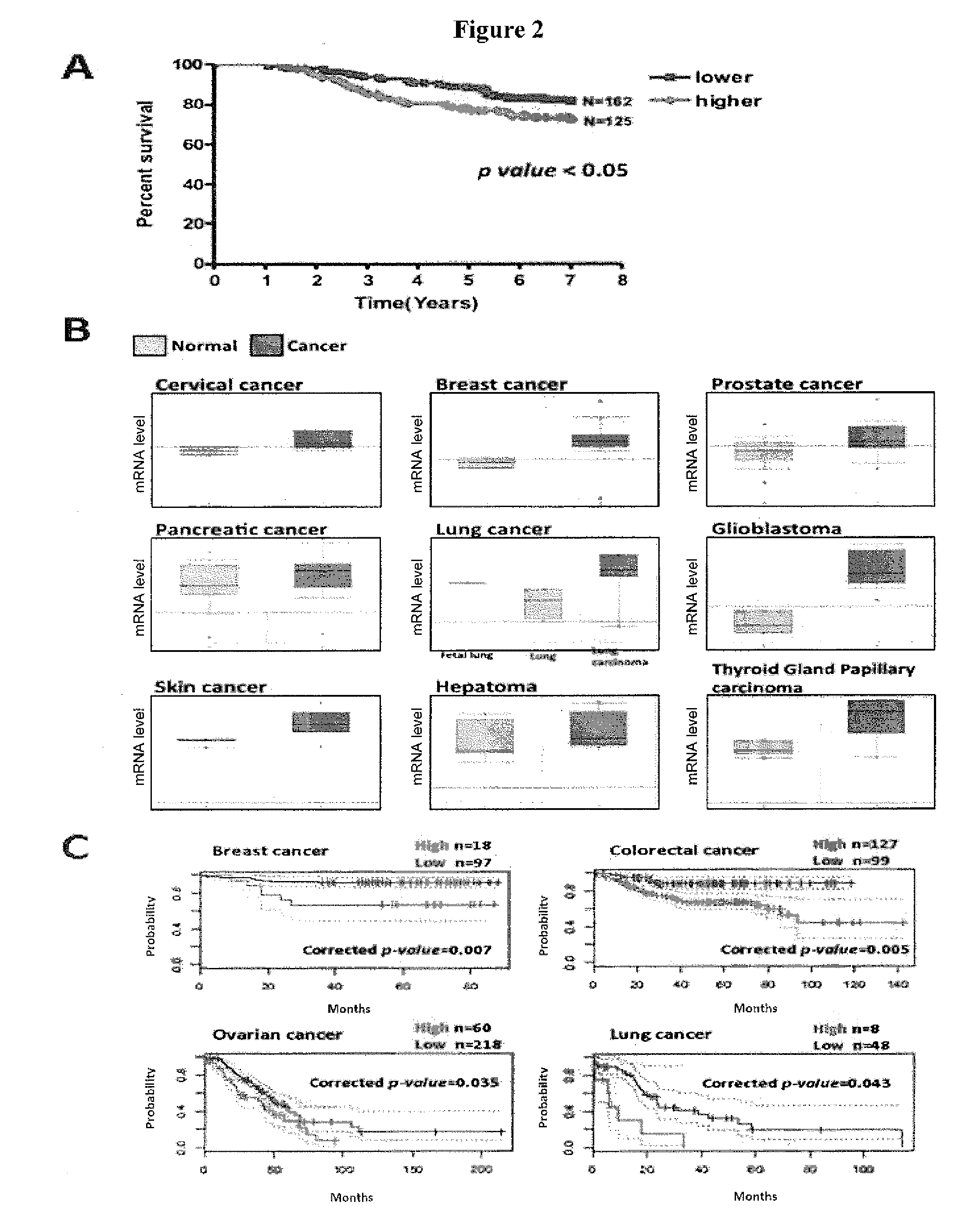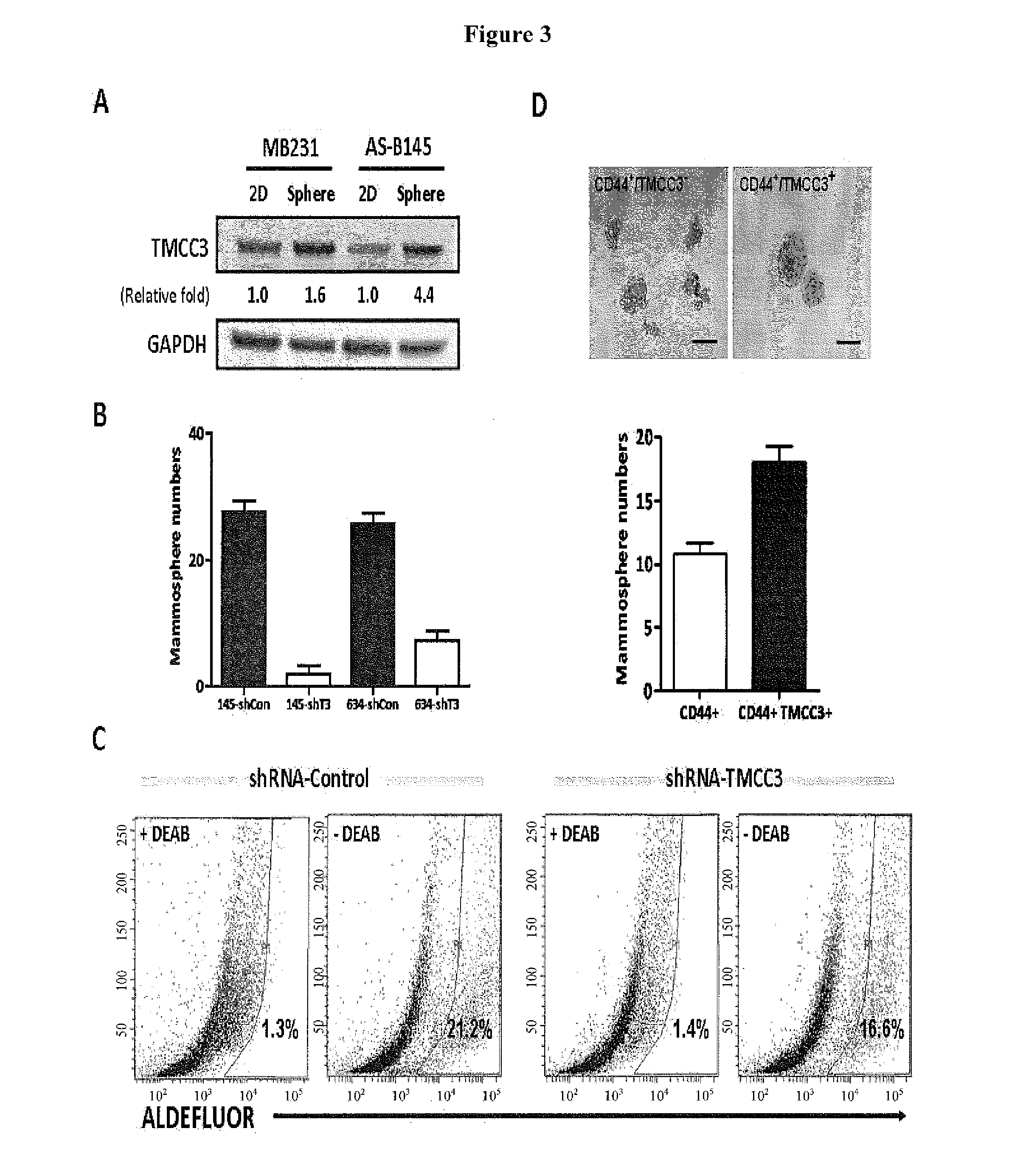Methods for suppressing cancer by inhibition of tmcc3
a technology of tmcc3 and cancer, applied in the field of cancer treatment, can solve the problems of recurrent disease, recurrence disease remains a challenge, and no reliable and validated biomarkers specific for early detection of cancer
- Summary
- Abstract
- Description
- Claims
- Application Information
AI Technical Summary
Benefits of technology
Problems solved by technology
Method used
Image
Examples
example 1
Western Blot Analysis
[0129]Cells were lysed in RIPA buffer supplemented with phosphatase and protease inhibitors and boiled after mixing with protein loading buffer. Aliquots of cell lysates were subjected to SDS-PAGE, and the proteins were transferred to PVDF membranes. The membrane lots were blocked with TBST buffer containing 3% BSA for 1 hour at room temperature and then incubated with the respective primary antibodies diluted in TBST (containing 0.05% Tween20 and 3% BSA) overnight at 4° C. Subsequently, blots were washed and incubated with appropriate secondary antibodies in TBST. Anti-phospho-mTOR (Ser 2448), mTOR, phospho-Akt (Ser 473), Akt, p-FAK (Tyr 397), FAK, p-ERK1 / 2 (p44 / 42) and ERK1 / 2 antibodies were obtained from Cell signaling Technology. Anti-GAPDH antibody was from GeneTex Inc.
example 2
Mammosphere Formation Assay
[0130]Single cells were plated at a density of 1,000 cells per well in ultralow attachment plates (35 mm; Corning). Cells were grown in serum-free DMEM / F12, supplemented with B27 (1:50, Invitrogen), 20 ng / mL EGF and 20 ng / mL bFGF (BD Biosciences), and 10 ng / mL insulin (Sigma). The mammospheres were cultured for 7-10 d. Then the mammospheres with diameter >100 μm were counted.
example 3
Aldefluor Assay and Flow Cytometry
[0131]To measure the ALDH activity of lentiviral knocked down cells, the Aldefluor assay was performed according to manufacturer's (Stemcell Technologies) guidelines. sh-TMCC3 and sh-control transfected cells were suspended in Aldefluor assay buffer containing ALDH substrate, Bodipyaminoacetaldehyde (BAAA) and incubated for 30 minutes at 37° C. To distinguish between ALDH-positive and -negative cells, a fraction of cells was incubated under identical condition in the presence of the ALDH inhibitor, diethylamino benzaldehyde (DEAB). This results in a significant decrease in the fluorescence intensity in ALDH-positive cells and was used to compensate in the flow cytometric analysis.
PUM
| Property | Measurement | Unit |
|---|---|---|
| dissociation constant | aaaaa | aaaaa |
| dissociation constant | aaaaa | aaaaa |
| pH | aaaaa | aaaaa |
Abstract
Description
Claims
Application Information
 Login to View More
Login to View More - R&D
- Intellectual Property
- Life Sciences
- Materials
- Tech Scout
- Unparalleled Data Quality
- Higher Quality Content
- 60% Fewer Hallucinations
Browse by: Latest US Patents, China's latest patents, Technical Efficacy Thesaurus, Application Domain, Technology Topic, Popular Technical Reports.
© 2025 PatSnap. All rights reserved.Legal|Privacy policy|Modern Slavery Act Transparency Statement|Sitemap|About US| Contact US: help@patsnap.com



